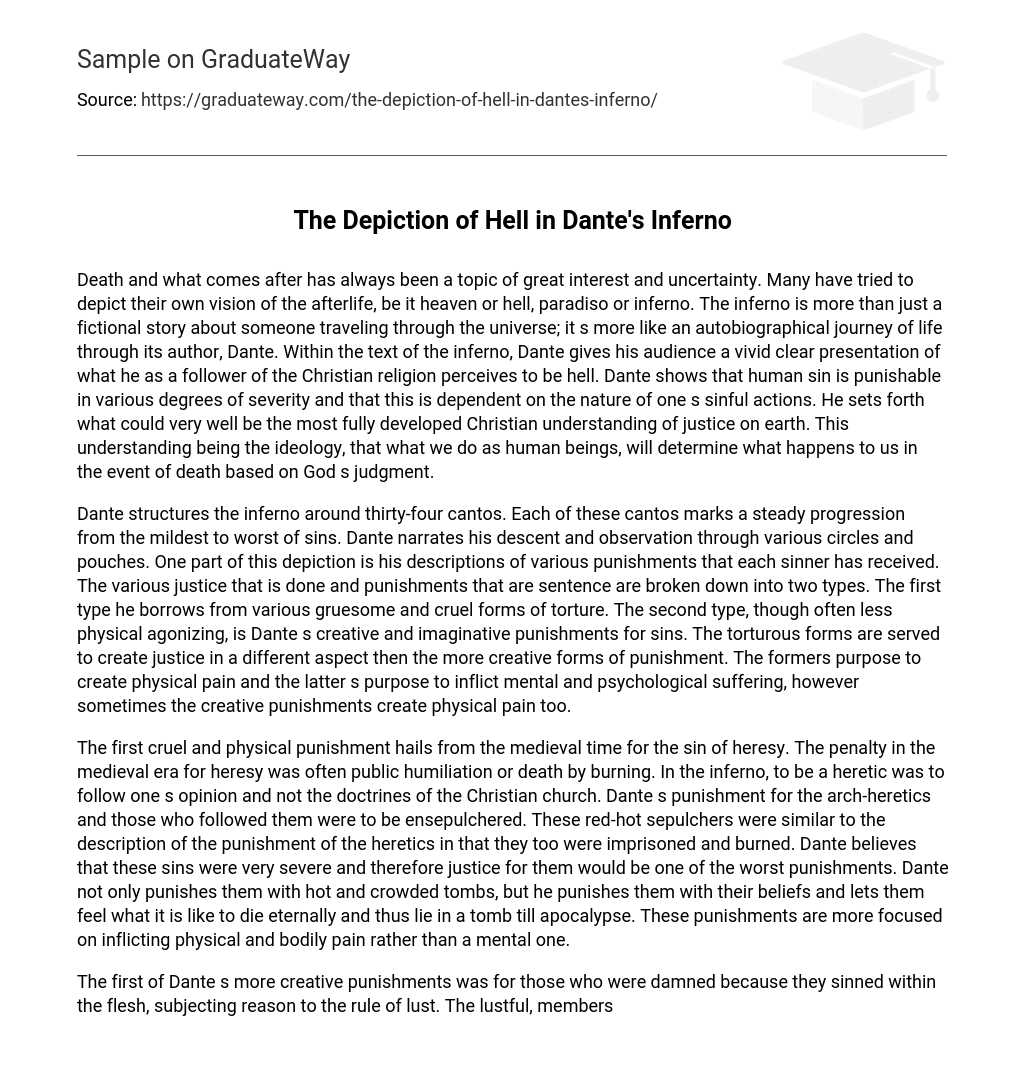The concept of death and the afterlife has always intrigued and perplexed people. Many individuals have tried to depict their own interpretations of what awaits beyond death, whether it is heaven or hell, paradiso or inferno. The inferno is not merely a fictional story about traveling through the universe; it is more like a personal journey through life by its author, Dante. Within the pages of the inferno, Dante gives his audience a vivid and explicit portrayal of what he believes to be hell as a devout Christian. Dante reveals that human wrongdoings are punished to varying degrees based on the nature of one’s sins. He presents a comprehensive Christian understanding of justice on Earth, emphasizing that our actions as humans determine the consequences we face in the afterlife according to God’s judgment.
Dante organizes the inferno into thirty-four cantos, each representing a progression from lesser to greater sins. He chronicles his descent through different circles and pouches, detailing the punishments inflicted upon the sinners. These punishments can be classified into two types: the first type draws inspiration from cruel forms of torture, while the second type reflects Dante’s imaginative and creative approach to punishment. The former aims to cause physical pain, while the latter seeks to inflict mental and psychological suffering, although there are instances where the creative punishments also result in physical pain.
In the medieval era, the sin of heresy was met with cruel and physical punishment, such as public humiliation or death by burning. Following one’s own opinion instead of the Christian church’s doctrines was considered heretic. Dante chose to punish arch-heretics and their followers by ensepulchering them in red-hot tombs, similar to how heretics were punished. According to Dante, these sins were severe and deserving of one of the worst punishments. The condemned not only experienced hot and crowded tombs, but also endured their beliefs and the eternal feeling of dying, lying in a tomb until the apocalypse. These punishments aimed to inflict physical suffering rather than mental torment.
Dante’s first creative punishment was for those who sinned within the flesh and allowed lust to rule over reason. The lustful, who belong to the group known as the incontinent, are forever condemned to whirl endlessly in a hellish hurricane that never ceases. Dante’s punishment for those consumed by lust and adultery is both original and uncomplicated. Like their chaotic existence driven by desire in life, the lustful are now caught in a storm, swirling aimlessly. While they endure intense physical discomfort, the true punishment lies within their minds. Due to their inability to control their desires, they are eternally condemned to a life devoid of control. This condemnation exemplifies how Dante’s justice is served through methods that differ from mere physical pain.
One of Dante’s clever and inventive penalties is reserved for the avaricious and prodigal individuals. The avaricious sinners, who were stingy in life, and the prodigal sinners, who were wasteful, are both subject to this punishment. Dante’s approach involves pairing the two groups together, and having them roll weights in a semi-circle until they collide. These punishments do not inflict physical torment, except for the act of pushing the weight back and forth, which is intended to cause psychological distress.
Dante’s journey into hell reflects the struggles that humanity faces. He emphasizes the importance of understanding and rejecting evil in order to endure hardship, stating that morality and intellect are necessary for this. To persevere, one must unite their spirit and remain brave. Dante remarks that in hell, souls have lost their intellectual goodness. Through reason, he confronts evil. The absence of fear for God leads to the pursuit of evil and consequent punishment in accordance with God’s will. All those who die under God’s wrath suffer the same fate, regardless of their location or background. Questioning God’s will is unacceptable. Facing trials that lead to eternal life with God is crucial. In the inferno, justice aligns with God’s will and punishes those who lived purposeless lives and committed sins. These individuals have no hope even in death, envying the fate of others. They are denied mercy and justice and live in eternal suffering, knowing that they are not missed on Earth.
Dante’s Inferno explores the correlation between earthly existence and the afterlife while also conveying key Christian principles. The poet illustrates hell as an inequitable yet justified realm of ceaseless torment, characterized by absolute despair. Within the circular structure of hell, each tier showcases punishments tailored to the nature of the sins committed. While these penalties may appear illogical and unfair by today’s standards, they were appropriate and fitting during Dante’s time.





